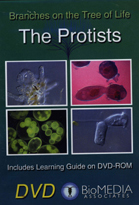
The Biology of Protists (VHS)
Branches on the Tree of Life: Protists (DVD) 2003
Distributed by BioMEDIA Associates, PO Box 1234, Beaufort, SC 29901-1234; 877-661-5355
Produced by eBioMEDIA
Director n/a
DVD and VHS, color, VHS - 20 min.; DVD - 45 min.; computers with DVD-ROM drives and Adobe Reader 4.0 or later are required
Jr. High - lower level college
Biology, Science, Teacher Training
Date Entered: 11/03/2004
Reviewed by Gloria Maxwell, Reference Librarian, Penn Valley Community College, Kansas City, MOSingle celled eukaryotic organisms are referred to as protists. This video attempts to show that this group is not just one branch on the tree of life, but several diverse branches instead. Formerly considered to be just one kingdom - kingdom Protista - that thinking is being challenged by new molecular analyses. The suggestion exists that perhaps an additional kingdom might be warranted.
Narrated modules cover the definition and examples of Protists, followed by the Euglenids; Diatoms and their relatives; Amoebas and Heliozoans; Green Protists; Colonial Protists; Insiders; Ciliated Protists; and Parameciums.
Following the general definition of protists, the program moves to euglenids. This group is extremely diverse and so different from the other lines of life that some biologists recommend placing them in their own kingdom. Diatoms and their relatives demonstrate that structure by itself is an insufficient method for defining relationships. In the segment on amoebas and heliozoans, viewers see their abilities at engulfing other organisms. The module on green protists shows the great diversity of the “green line” of evolution. Colonial protists provide an evolutionary bridge between single cells and multicellular organisms. Insiders are what live in other animal species. Called protistan symbionts, some are parasites, while others are harmless commensals; some actually help the species they inhabit. Ciliated protists are considered the dinosaurs of micro-space. Here are the “classical protozoans” found in pond water samples. Paramecium demonstrate how life processes are carried out by independently living cells. Since paramecium are one of the standard specimens studied in biology labs this module will be particularly useful in demonstrating principles and behaviors of this organism.
Every organism shown in the video came from bird baths, local ponds, roadside ditches, or horse troughs. For classroom laboratories, protists collected from any of these habitats will thrive in jars of water if kept at room temperature and out of direct sunlight. The color photography of living organisms is superb and augments the narration. Music and sound effects are pleasant and add to the overall viewing experience.
The video is designed for each module to be viewed independently, stopping for discussion, and then resuming viewing to summarize the content. Laboratory observations of organisms such as parameciums and volvox will reinforce concepts outlined in the video.
The DVD interactive learning guide provides menu-driven modules that are easy to navigate. Information is clearly stated and enhanced by visual images. The graphics demonstrate the principles and actions being described and explained. The teaching guide is available for free download on the eBioMEDIA web site, together with free images and significant other content areas to support the teaching of biology.
The Biology of… series is a high quality product that supports classroom instruction with concise, understandable facts enhanced by visual images and graphics that support the concepts outlined in each section. This program would be suitable for Junior and Senior High Schools, as well as beginning level college biology courses. Highly recommended.